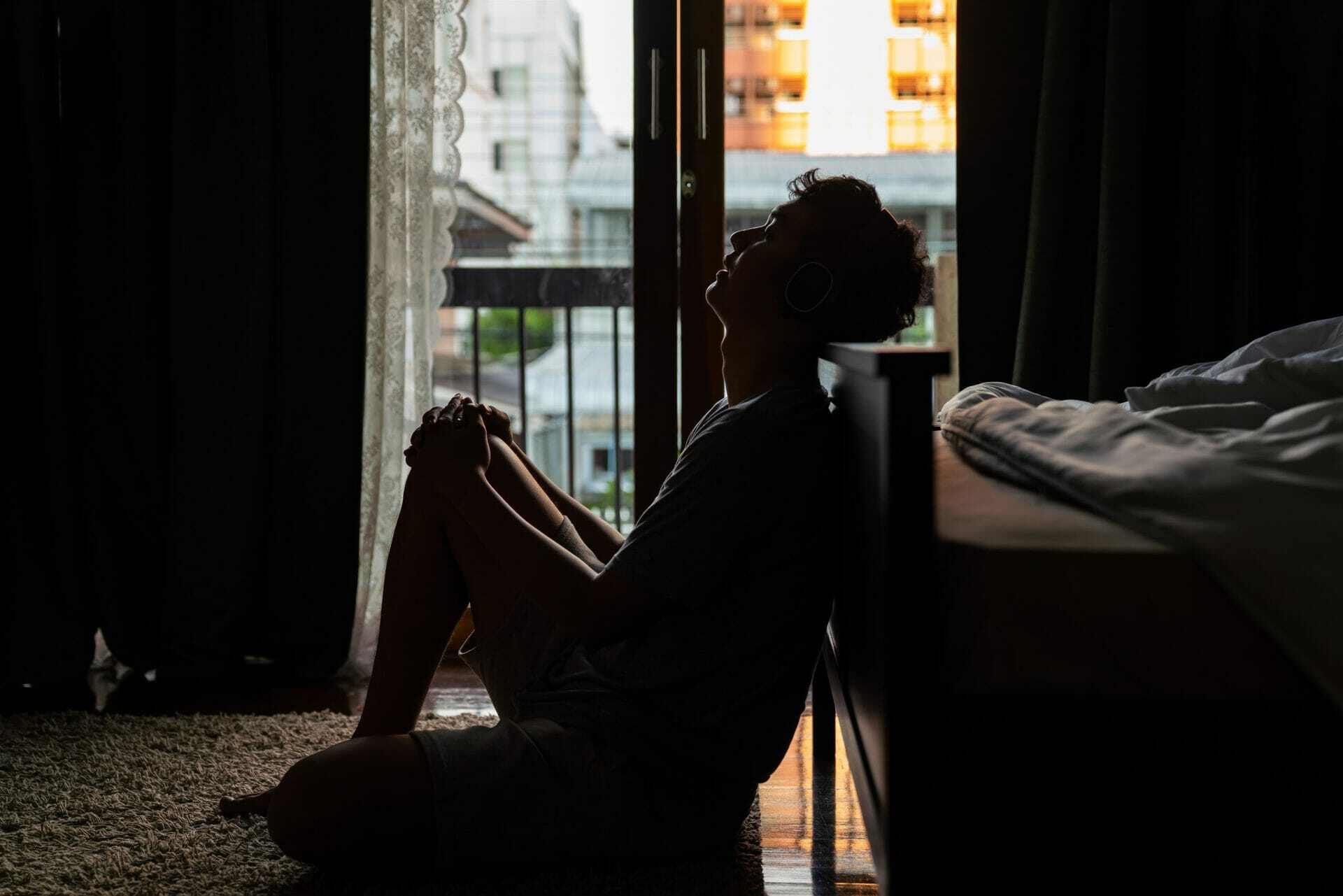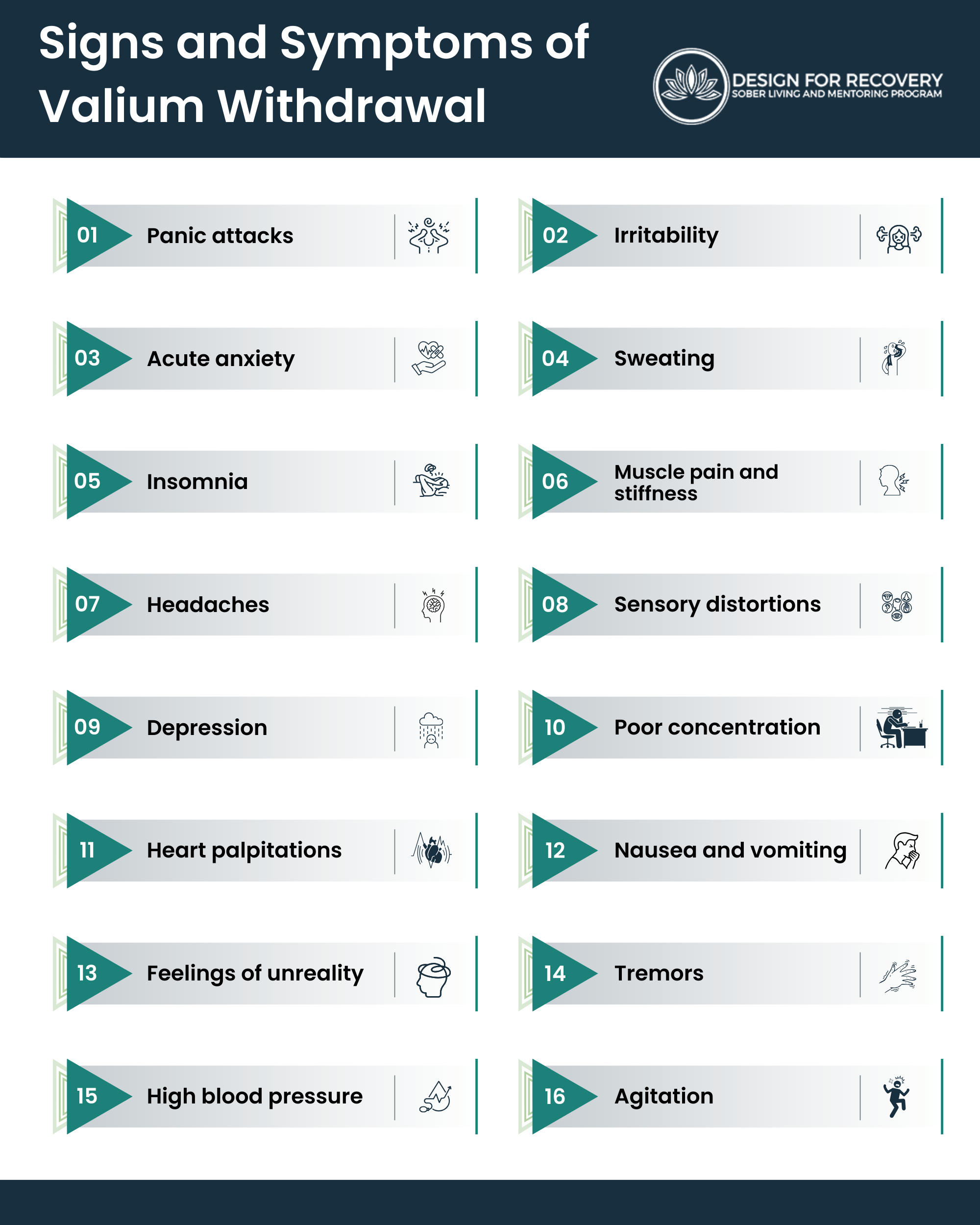Valium is the brand name for the drug diazepam. It is the 135th most prescribed drug in the United States, with more than 5 million prescriptions in 2017 alone. Diazepam is classified as a benzodiazepine, a class of drugs that is primarily used to treat the symptoms of anxiety disorder, panic disorder, insomnia, and even alcohol withdrawal symptoms and opioid withdrawal symptoms. Valium is one of the most prescribed drugs in the United States, and it can be effective at providing relief when it is used as prescribed. However, the drug can lead to physical dependence and addiction even when it is taken exactly as prescribed. It is also a widely abused recreational drug. When Valium is abused or misused, the result is generally physical dependence and addiction. Once a person has become dependent on Valium, they will experience painful withdrawal symptoms when they stop using the drug. These Valium withdrawal symptoms are extremely painful, debilitating, and in some cases even life threatening.

Signs and Symptoms of Valium Withdrawal
Withdrawing from Valium, or any benzodiazepine, results in a variety of symptoms. These symptoms can be broadly classified into two categories: rebound symptoms and withdrawal symptoms. Rebound symptoms represent a return of symptoms that the person originally was using Valium to treat. Often, these symptoms return at a far more extreme level than before. For example, a person who took Valium to treat an anxiety disorder may begin to experience worse anxiety when they quit Valium. Withdrawal symptoms can be even more severe, however. Symptoms of benzodiazepine withdrawal include:
- Panic attacks
- Irritability
- Acute anxiety
- Sweating
- Insomnia
- Muscle pain and stiffness
- Headaches
- Sensory distortions
- Depression
- Poor concentration
- Heart palpitations
- Nausea and vomiting
- Feelings of unreality
- Tremors
- High blood pressure
- Agitation
Individuals who developed severe physical dependence on Valium or other benzodiazepines are at risk of even more severe symptoms. These include delirium tremens, seizures, and acute psychosis. These symptoms can be fatal, especially if a person withdraws from benzodiazepines all at once — also known as “cold turkey.”

Call Design for Recovery to Begin Your Healing Journey!
Reach out to our team to discuss sober living options and next steps toward a healthier routine.
What Causes Valium Withdrawal
Valium is in many cases a medically necessary drug, and so it is frequently prescribed to treat anxiety disorders, panic disorders, insomnia, and related conditions. However, it is important to understand that Valium, like other benzodiazepines, can quickly lead to physical dependence. Individuals taking Valium as prescribed by a doctor are no exception to this risk, and they are as vulnerable to the addictive qualities of Valium as people taking the drug for purely recreational purposes.
Even after a short period of taking Valium, most people rapidly develop a tolerance to the effects of Valium. As a result, they will experience weaker effects while taking the same dosage. Once a person has developed a tolerance, it can be very tempting to take higher quantities of Valium or take the drug more frequently. By increasing the dosage, individuals can achieve the relief or high that they are accustomed to. By increasing the dosage, however, individuals not only increase their Valium tolerance further, but they can develop a debilitating physical dependence on Valium. It is important to note here that this physical dependence can occur with people who have increased their dosage through misuse and abuse, but it can also occur when people take their medication exactly as prescribed.
Once a physical dependence has occurred, the result is that when a person stops taking Valium or decreases their dosage they will experience a variety of uncomfortable symptoms. These symptoms, known as Valium withdrawal or benzodiazepine withdrawal, are the body’s way of reacting to the absence of a chemical that it has grown accustomed to.
Valium and other benzodiazepines are central nervous system (CNS) depressants. This means that their basic effect is slowing down and inhibiting the central nervous system. The central nervous system, consisting primarily of the brain and spinal cord, coordinates thinking and influences activity in all parts of the body. When a person has grown accustomed to Valium and developed a tolerance, that essentially means that their body has learned to balance the effects of Valium. The body counteracts these effects by increasing the activity of the central nervous system, thereby achieving a kind of balance. When a person stops using Valium, however, this precarious balance is upset, and the result is dangerous overstimulation.
How Long Does Valium Withdrawal Last?
The Valium withdrawal timeline is notoriously unpredictable. Most people begin to experience the initial effects of Valium withdrawal after only a few hours have passed since their last dose. However, the progression of Valium withdrawal and how long it lasts depends on a wide range of factors. Some people experience Valium withdrawal for only a few days, while others suffer from the symptoms for many weeks — or even months.
Individual factors that can affect the progression and length of Valium withdrawal include:
- The quantity of Valium a person took
- How frequently the person took Valium
- The last time they misused Valium
- Whether they took other drugs alongside Valium
- Height and weight
- Age
- Family history of substance use disorders
- Personal medical history
- Whether a person is using other medications during detox
- The method of detox being used during withdrawal
Benzodiazepine withdrawal is unique in many ways. During the course of withdrawing from most other substances, there is a predictable timeline: people experience initial withdrawal symptoms, followed by peak intensity symptoms, after which symptoms gradually level off. In the case of benzodiazepine withdrawal, however, people often experience a reduction of symptoms only to have their withdrawal symptoms suddenly peak once more. Withdrawal symptoms can wax and wave unpredictably during the course of the withdrawal process.
Most people begin to see more serious improvements after approximately two months. However, it is important to recognize that many people, even individuals who were only taking Valium at low doses, continue to experience withdrawal symptoms for 6-12 months afterwards.
Approximately 10% to 15% of people suffer from protracted withdrawal syndrome, sometimes known as post-acute withdrawal syndrome. For these individuals, benzodiazepine withdrawal sometimes can last months longer, in some cases even years longer. Generally these symptoms are not as severe as peak withdrawal symptoms, but they can make it difficult to lead normal leaves. Common symptoms of post-acute withdrawal syndrome include insomnia, psychosis, cognitive deficits, tinnitus, gastrointestinal problems, tingling and numbness, pain in the limbs and extremities, muscle pain, tension, weakness, shaking attacks, painful tremors, dizziness, jerks, and involuntary eyelid contractions.
Withdrawing from benzodiazepines slowly by using a tapering method reduces the likelihood of protracted withdrawal syndrome and the more dangerous side effects of Valium withdrawal. By seeking outside help and getting support during the recovery process, people can also better face the challenges of Valium withdrawal, decrease the chances of relapse, and build better lives for themselves in sobriety — all of which serve to mitigate unpleasant symptoms even when they do occur.
Contact Design for Recovery Today!
Fill out our quick form to connect with a peer mentor and learn how our sober living community supports accountability, structure, and personal growth in recovery.
Tips for Dealing with Valium Withdrawal Symptoms
Individuals with severe physical dependence on Valium should always withdraw from the drug under the supervision of trained medical professionals. However, even people who are not facing life-threatening withdrawal symptoms are likely to suffer considerably. Not only can benzodiazepine withdrawal cause debilitating emotional, cognitive, and physical difficulties, but the cravings that occur can be hard to ignore. Getting the outside help of a support system is essential for handling this difficult condition.
However, there are many things that people who are facing Valium withdrawal can benefit by keeping in mind. First of all, it is important to recognize that experiencing Valium cravings is a normal part of the recovery process. Understanding that cravings are normal can help people perceive them as just passing thoughts or emotions. No one has to act on their cravings. Even when cravings are accompanied by severe emotional or physical distress, cravings cannot force a person to use drugs. By accepting cravings for what they are, people can learn to acknowledge them and move on with their lives.
Many people also fear that Valium withdrawal will stay with them throughout their lives. This is partly due to the nature of the Valium withdrawal timeline, which is infamously unpredictable. While it is true that some people experience cravings once in a while years after recovering from their addictions, these cravings tend to get weaker over time, and if you have a strong program of sobriety and a support system in place you’ll be well-prepared to face any annoying cravings head-on.
A few techniques for managing Valium cravings include:
Don’t fight your cravings. Instead, it is better to accept them. Many people think that having cravings is bad or means that they are not recovering “correctly.” The reality is that resisting or denying your feelings can build up tension and distress. It is generally a better idea to calmly accept the fact that you’re experiencing a craving, recognize it as a normal part of the process, and go on with your day.
Understand your personal triggers. Everyone has different triggers that make them want to abuse their substance of choice. These triggers might relate to previous patterns of drug use: we might associate certain places, people, or events with Valium abuse. Some people discover that they get cravings when they are experiencing certain strong emotions. Some triggers are avoidable: many people, for instance, benefit from avoiding certain places, certain people, or even entering a romantic relationship in their first year of sobriety. Other triggers are harder to avoid, but it is still possible to develop strategies for dealing with them. By recognizing your triggers, you can make plans to handle them.
Make use of healthy distractions. You don’t need to sit in bed and wait for the withdrawal symptoms and cravings to pass. Even if you feel miserable and don’t feel like doing anything, being active and making use of healthy distractions can help reduce your feelings of distress. Healthy activities include playing sports, watching movies, reading, going for a walk in nature, listening to music, taking a bath, or calling a friend.
Seek help. Probably the most fundamental aspect of recovery from any addiction is developing a strong sober support system. Support groups and sober living homes help people feel less alone during the recovery process, and they allow people to benefit from the experiences, advice, and strength of other people. Moreover, these programs generally help people develop new tools and coping techniques for dealing with the challenges of Valium withdrawal and early sobriety.
Is Valium Addiction the Same as Dependence?
Valium not only rapidly leads to physical dependence. It is very addictive as well. Part of the reason Valium is so addictive is that when a person takes Valium, the drug releases high quantities of dopamine in their brain. Dopamine is a neurotransmitter that plays an important role in the brain’s motivation and decision-making centers. It is sometimes known as the “reward chemical” because when it is released in the brain it rewards and reinforces certain behaviors. Because Valium and other addictive drugs release such high quantities of dopamine in the brain, users are likely to be drawn to the drug again and again.
It is important to recognize that while most people who develop Valium dependence also develop Valium addictions, these two conditions are not the same. In fact, it is possible to recover from a physical dependence on Valium and still continue to suffer from a Valium addiction.
What is Valium addiction? Valium addiction is a type of benzodiazepine use disorder, which in turn is a category of substance use disorder. Substance use disorders occur when a person experiences severe negative consequences from their drug or alcohol use but is unable to manage their own intake of substances. Individuals suffering from Valium addiction may recognize the harms that the drug is inflicting in their lives, but they are often helpless to stop using the drug.
Recognizing this distinction between physical dependence and addiction is necessary for anyone who hopes to recover. In many cases, people do manage to stop using Valium for a period of time. Doing so often requires them to spend countless painful weeks and months withdrawing from the drug. It may seem crazy, but even after undergoing this arduous process of Valium detox, many people ultimately relapse on the drug? Why do they return to Valium after going through all that effort? The answer is that they suffer from Valium addiction. Individuals suffering from a benzodiazepine use disorder will continue to obsess over Valium even after they have recovered from the state of physical dependence.
It is highly recommended that people get outside help to treat their Valium dependence, but over the long term it is even more important that people get help for their addictions. Treating the underlying issues, behaviors, and thought processes that give rise to addiction is essential for anyone hoping to stay clean and sober.
Getting Help for Valium Abuse and Valium Addiction
It is often tempting for people to shrug off their Valium abuse. Even though Valium is an extremely dangerous and addictive drug, many people are under the misconception that it is safe because it is a prescription drug. In fact, withdrawing from Valium can be more dangerous than withdrawing from so-called “street drugs” like heroin and crack cocaine. Not only can the symptoms be painful and deeply debilitating, but without outside help and supervision the symptoms of Valium withdrawal can sometimes even be life threatening.
Unfortunately, the vast majority of people who suffer from Valium addiction are reluctant to seek help. Far too many people tell addicts to “man up” or simply pressure them to work harder to control their substance use. As a result, a high percentage of people with substance use disorders try and fail to get sober for years, believing that their problem is that they lack sufficient will power. The reality is that substance use disorders are legitimate mental health conditions that cannot be managed through sheer willpower alone. Seeking the help out a strong sober support system is essential.
Design for Recovery is a structured sober living home for men located in West Los Angeles. Design for Recovery offers young men an opportunity to recover from Valium addiction — or any other addiction — in a safe, comfortable, and trigger-free environment. While living at Design for Recovery, residents connect with one another, benefiting from the experience, strength, and hope of their housemates. Meanwhile, they work diligently each day to develop the skills, tools, and coping strategies they need to handle triggers, avoid relapse, and meet the challenges of early recovery. At Design for Recovery, we believe that quitting drugs and alcohol is only half the battle. Our residents not only work hard to stay sober, but to develop lives that are meaningful and fulfilling.
If you are ready to end the vicious cycle of Valium abuse and build a new life for yourself, you don’t have to do it alone. Contact Design for Recovery today.
- Signs and Symptoms of Valium Withdrawal
- What Causes Valium Withdrawal
- How Long Does Valium Withdrawal Last?
- Tips for Dealing with Valium Withdrawal Symptoms
- Is Valium Addiction the Same as Dependence?
- Getting Help for Valium Abuse and Valium Addiction







Written By
David Beasley